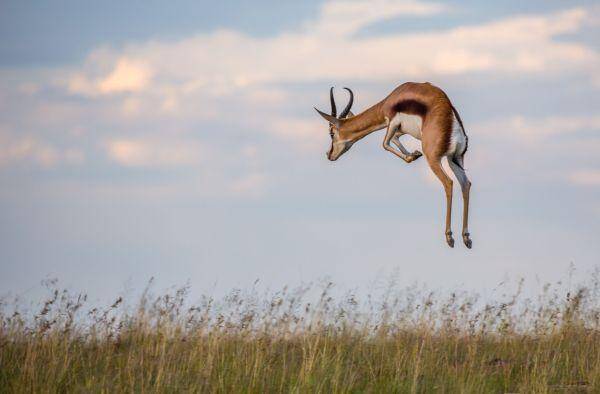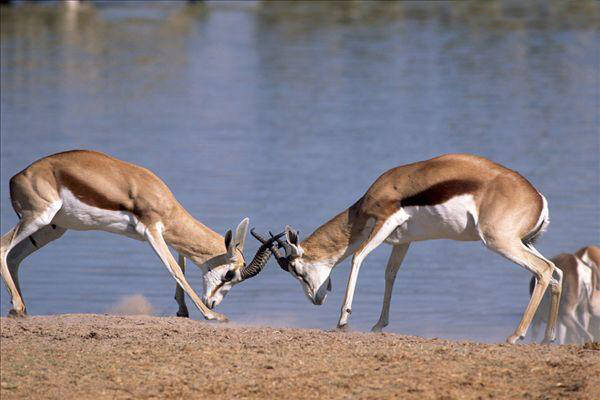Antidorcas marsupialis
IUCN
LCBasic Information
Scientific classification
- name:Antidorcas marsupialis
- Scientific Name:Antidorcas marsupialis
- Outline:Ungulata
- Family:Artiodactyla Bovidae Springbok
Vital signs
- length:120-150cm
- Weight:37-50kg
- lifetime:7-9years
Feature
Born to run and jump, it can reach a speed of 94 kilometers per hour, can jump up to 3.5 meters, and can jump up to 10 meters.
Distribution and Habitat
Origin: Angola, Botswana, Namibia and South Africa. Uncertain: Lesotho.
Savannah-dwelling, prefers dry and open environments. Lives in arid or semi-desert grasslands with scrub. Mostly confined to game reserves and farms and the edges of dry lake beds, related to barren savannas.
Appearance
The springbok is 1.2-1.5 meters long, 68-90 centimeters high at the shoulder, and weighs 37-50 kilograms. It has slender limbs. The fur on the back is yellow-brown, and the buttocks, back, abdomen, and inner sides of the limbs are all white. There is a reddish-brown stripe between the back and abdomen on both sides of the body. There is a longitudinal fold formed by the concave skin in the center of the back. The fur inside the fold is white. When it is frightened and starts to run away, the fold unfolds and a clear white ridge appears, which is a signal to warn its companions. Both males and females have horns, which are black with rings.
The upper part of the springbok's body is bright cinnamon brown, and the lower part is white. There is a wide chocolate brown stripe along the waist, the face and snout are white, there is a reddish-brown stripe from the eye to the corner of the mouth, and the buttocks are white. The tail is thin, with a tuft of black hair at the end. From th
Details
Springbok (scientific name: Antidorcas marsupialis) is called Springbok in foreign language. There are 3 subspecies.

Springboks migrate long distances in large groups in the dry season in search of new pastures. They feed on grass and shrub shoots, and will not drink water if there is enough green grass. Living in groups, they are naturally good at running and jumping, and can reach a speed of 94 kilometers per hour, second only to pronghorns and cheetahs. They can jump up to 3.5 meters and up to 10 meters. They use this method to deal with their number one natural enemy, the cheetah, to jump to avoid the cheetah's attack or disrupt its sight. In the Karoo area, it is a true desert antelope, and can almost live for a long time without drinking water. It is widely distributed.
Springboks feed on branches and leaves of plants, and sometimes eat stems. Their diet is very wide, and the food changes with the seasons, but they choose more nutritious ones. They eat grass, herbs, shrubs, seeds, pods, fruits and flowers, and sometimes dig up the surface to find melons, and also choose plants that are poisonous to other antelopes. They eat wild melons to make up for the lack of water in the body, and eat soil to supplement the lack of minerals in the body.
The natural enemies of springboks are mainly cheetahs, which are faster than them. Leopards often attack springboks when they are not paying attention. In addition, crocodiles in the river will attack them by surprise. Falcons and jackals will also take springboks as food. Hyenas and vultures are also their natural enemies. Because they are easy to raise, they have become famous ornamental animals in zoos.

During the mating season, male springboks mostly wander together to find mates, while females live in groups with their own offspring and very few dominant males. Wandering males have a lower status. Some of those who are in a low ranking are too young or very old, and some are losers in the competition with the male leader of the herd during the female estrus period.
Springboks mate in May and have a gestation period of six months. The peak birth period occurs at the beginning of the rainy season, in October and November. The gestation period is about 4-6 months, with one calf born per litter, and the lactation period is 5-6 months. Females generally give birth every two years, and the average life expectancy of springboks is 7-9 years.
The East African Wildlife Society (EAWLS) estimated in 1999 that the total number of springboks in southern Africa was more than 670,000, noting that this may be an underestimate. The latest estimate for Namibia alone puts the number in that country at 730,000, which is itself an underestimate (P. Lindeque, Skinner, 2013). Elsewhere in the range, 2013 estimates put the population at probably about 10,000 in Angola, about 40,000 on the Botswana side of the Ankara Frontier Park (and at least 60,000 in the rest of the country), and 75,000 in Angola. 75,000 in the Free State, the former Transvaal Province, 1,000,000 in the Karoo, and about 100,000 in the Cape Province outside the Karoo. Based on these figures, the total population size in southern Africa is estimated at about 2 million. 2,000,000-2,500,000 animals (Skinner 2013).
Listed in the IUCN Red List of Threatened Species (IUCN) 2016 ver 3.1 - Least Concern (LC).
Protect wild animals and stop eating game.
Maintaining ecological balance is everyone's responsibility!








